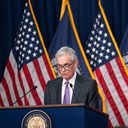What Fed officials are hinting about rates in the long-run

Amid this week's rush of central banking news, it would be easy to miss one small piece — an oh-so-slight upward move in what the median Federal Reserve policymaker believes the central bank's target interest rate will be in the longer run.
Why it matters: This kind of incremental move is exactly what we'd expect to see more of if the economy will feature persistently higher rates than it has for most of the last 15 years.
- And that, in turn, would have sweeping, negative implications for nearly all asset prices, the outlook for real estate and other interest-sensitive sectors, and the U.S. government's fiscal sustainability.
Driving the news: The median Fed official now expects interest rates to be somewhat higher in 2025 and 2026 than they did in December — anticipating fewer rate cuts will be justified in the coming two years.
- The median projection for the longer-run rate also ticked up, to 2.6% from 2.5%.
- Seven of 19 top policymakers now think rates will be 3% or higher in the long run, up from four in December.
- Chair Jerome Powell played down the move's significance in his Wednesday news conference, noting that they were "pretty modest changes."
What they're saying: "In terms of 'are rates going to be higher in the longer run?' ... I don't think we know that," Powell said.
- He added that "rates were generally low during the pre-pandemic post-global financial crisis era for reasons that are mostly important, slow-moving large things like demographics and productivity… things that don't move quickly."
- He said that "my instinct would be that rates will not go back down to the very low levels," adding that "there's tremendous uncertainty around that."
Between the lines: If a meaningful change is underway in the global cost of borrowing money — fueled by large fiscal deficits, the retirement of the Baby Boom generation, and a surge in demand for capital to be invested — it would reveal itself very gradually.
Flashback: Following the 2008 global financial crisis, economists and central bankers didn't wake up one morning and confidently proclaim that the cost of borrowing would need to hug zero for a decade to come.
- Rather, they learned about that structural shift in interest rates the hard way, repeatedly predicting rate increases — only to see major economies start to buckle in response.
The bottom line: If there has been a shift toward a new monetary order in the 2020s, it's likely we will learn it gradually as the Fed and other central banks make plans to cut rates, then find they must hold off because inflationary pressures don't dissipate according to expectations.
- And the "dots" that symbolize Fed officials' views of the long-term rate will change one at a time, like they did this week.